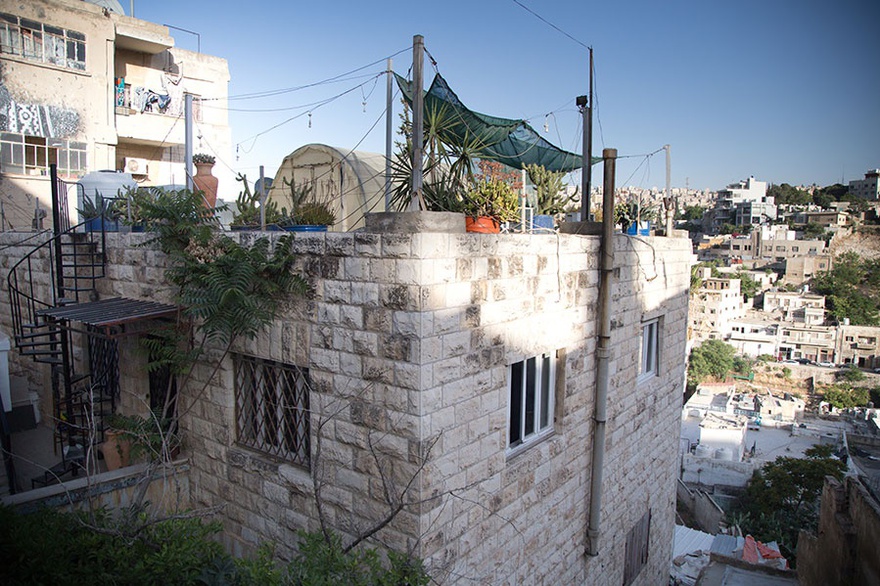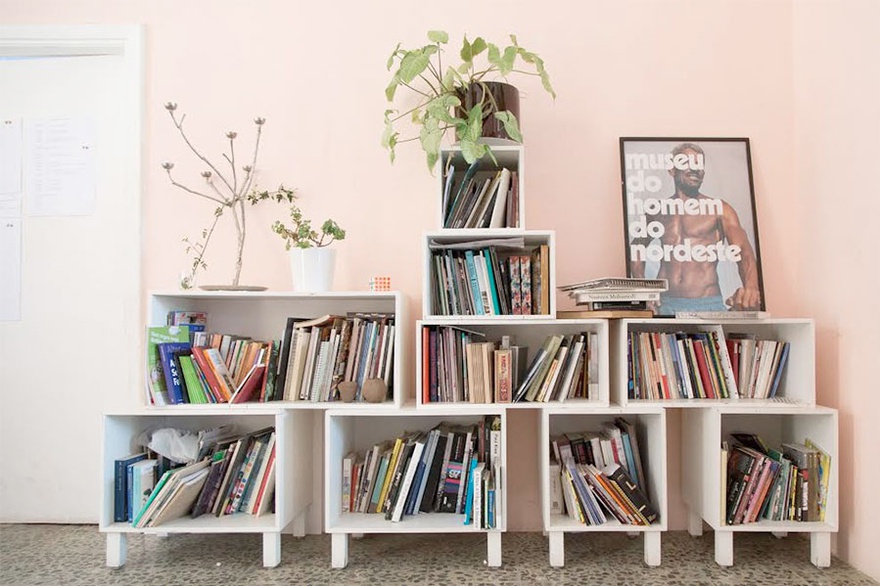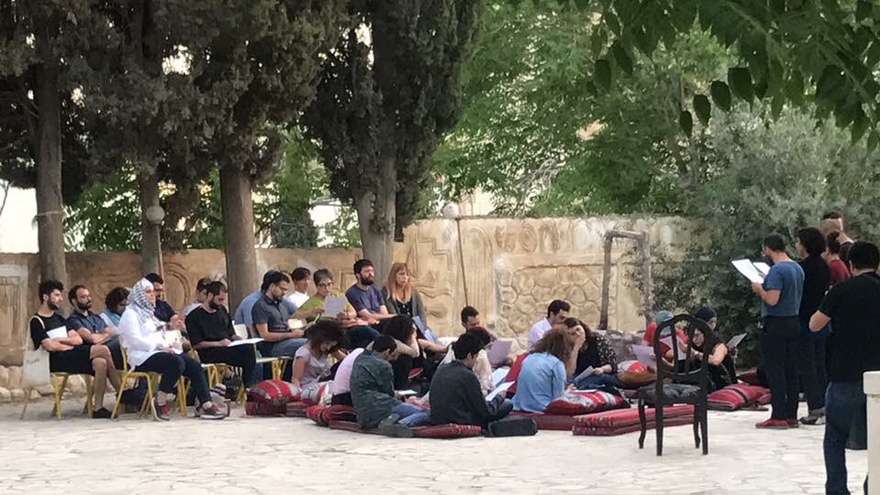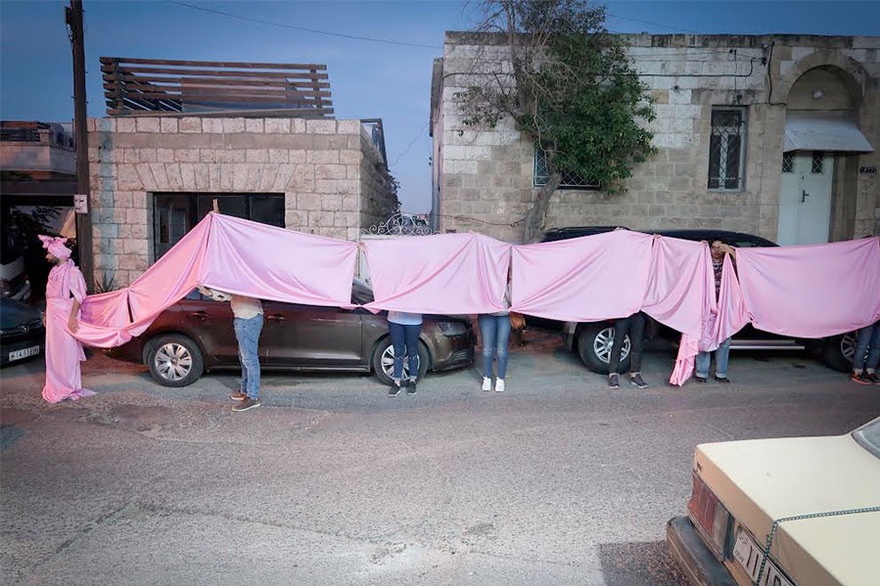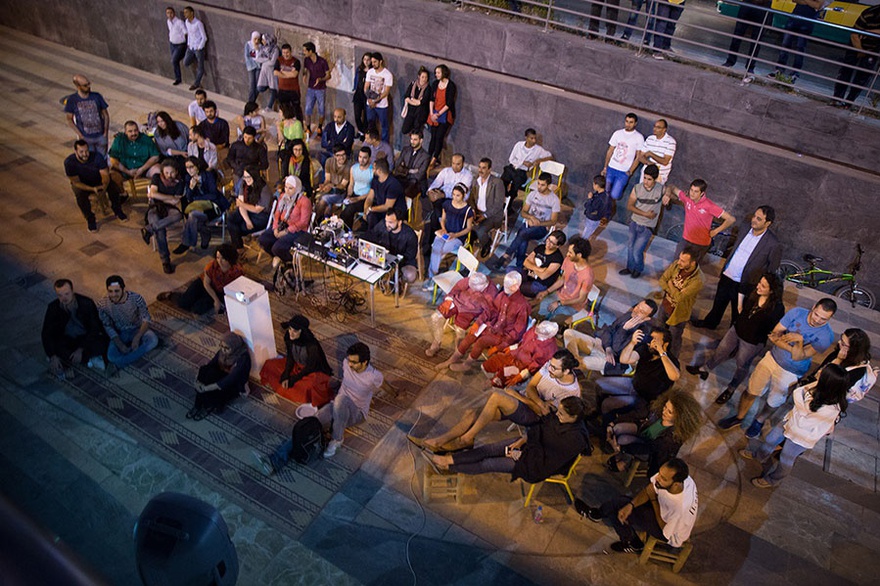Interviews
Creating Intimacies: On the Spring Sessions Programme in Amman
Toleen Touq in conversation with Reema Salha Fadda
Spring Sessions is an annual three-month art residency programme in Amman that was founded four years ago with a clear goal in mind: to address the absence of critical and experiential art education in Jordan. Initiated by Noura Al Khasawneh and Toleen Touq, the programme brings together international artists, to host participatory workshops and collaborative sessions with young and emerging artists (on average 18 participants per year) from across the globe. The artists and practitioners chosen to lead the sessions share in common a strong focus on collaborative ways of working, prioritising alternative pedagogies and critical methodologies. These have included Basma Al Sharif, Rheim Alkadhi, Michael Rakowitz, the design collective åbäke, Hong-Kai Wang, James Webb, Bahbak Hashemi Nezhad, and more recently the Cairo Institute of Liberal Arts and Brian Conley, several of whom have returned to the space to continue projects they have started in Amman. As such, the programme opens up a two-way exchange: to cultivate critical thinking and develop methodological approaches to art-making for participants seeking to develop their artistic practices; and, for the resident artists leading the sessions, Amman has offered a new site of creative praxis.
Now in its fourth year, Spring Sessions has seen over 80 participants and 30 resident artists and cultural practitioners take part in the programme. Over the course of the 15 week programme, held between the months of March and June of each year, participants work with mentors to produce a final project that is open to the public. The mentoring process guides participants to question modes of art production and works to consider the dynamic relationship between art and public space.
In a conversation with Toleen Touq, co-founder of Spring Sessions and Reema Salha Fadda, Commissioning Editor at Ibraaz, the two discuss the evolution of the programme, and the accumulative working process that centralises trust, friendship and creating intimacies amongst participants, educators and mentors.
RSF: I want to start by asking you how Spring Sessions was initiated. You describe it as a collaborative art residency programme that offers an independent and experimental education structure for young and emerging artists. This seems to be a conscious turn away from formal institutionalor curriculum-based teaching. Can you speak about how you arrived at this pedagogical structure?
Toleen Touq: Noura and I were interested to fill the gap in arts education that is prevalent in Amman but it was important for us not to formalise this through academic or hierarchical structures. We did not want to create a formalized art school or an institution, but rather, to create something that reflects how we work and builds on the networks we have developed over the years. We wanted to create a platform that is fluid, flexible and reacts to the context we are in. As a largely locally-funded initiative, enabled through the generous donation of private funders, we are not required to draw up agendas that meet the demands funders. This has meant that we can be flexible in our choices of programming topics for the year. Targeting local patrons has been a conscious decision from the start – it was our way of encouraging continued local support for the arts and cultivating independent networks of supporters. We are very lucky to have been working with funders that trust our vision for the programme and are invested in the work we do. As such, we don't see a clear separation between us and our funders; rather, they are committed individuals who are keen to work with us collaboratively on all aspects of the programme. As a very small team, this intimate structure gives us the flexibility to be site-responsive when it comes to what is needed each year and to react to participants needs accordingly.
I suppose the hospitable environment we are consciously seeking to create is bound to what we regard as the de-politicization of daily life in Amman. The importance of community building that guides our works at Spring Sessions is partly in response to the neoliberalisation of Amman – a city that is over-expanding and changing very quickly, yet one that still remains peripheral to the wider region. Within this, we wanted to create a program that changes our experience of working and learning together about our city, to consider all aspects of its development – from the mundane to the monumental. In this sense, being personal has meant being political.
We see Spring Sessions as an accumulative programme that takes into consideration the work of previous years, ensuring each iteration responds to the critical debates initiated by participants and artists who work with us, as well as the learning methodologies developed. This tends to cultivate a continued and lasting relationship amongst the Spring Session-ers, in which intimacy and trust is central to how we work. In several instances, participants and artists have returned to work with us on the programme. This has allowed a broad educational experience in large part because our participants come from different backgrounds and levels of experience. We have accepted visual artists, curators, educators, designers, architects, writers, engineers, chefs, researchers, historians, who together bring a diverse approach of working. We all share the desire and need to be in a context that allows for other forms of knowledge production to develop. I also think that by opening up a space where participants of different ages and artistic experiences can come together, the heterogeneity of the group structure creates unexpected conversations.
RSF: Each year the sessions take a different theme as its starting point. How do you decide on the content of the programme?
TT: Rather than thinking simply in terms of themes, the program is focused on developing different methodologies in arts learning as a response to the context we are working in. Every year comes with different ideas, but also a changing socio-political landscape and working from within different locations, as so the idea is to tailor each learning experience through contextual methodologies. Each year we host the workshops in different locations across Amman and immerse ourselves in different contexts and locations in and around the city, so it is very much concerned with responding to the neighbourhoods we are working in and the different questions we are engaged with in any given year. The programme therefore becomes an opportunity to introduce artists with new working practices that we too want to learn from. This has taken the programme to a broad range of working venues.
RSF: Can you talk me through how the programme has evolved over the years?
TT: For the first year our activities were centred on the King Ghazi hotel – a dilapidated hotel in downtown Amman that we helped renovate. Given it was our first year, it was the most challenging programme to date, as we were developing the working processes as we went along. We hosted 9 workshops, which ranged between three days to two week sessions, led by artists including Basma Al Sharif, Rheim Al Kadhi, James Webb, Eric Gottesman, Omar Negati (architect), Tony Chakar and Nick Jeeves (designer), Liane Al Ghussain and Raed Ibrahim. The program was strongly inspired by ideas of 'unlearning' and knowledge sharing.
The second year the sessions were held at another downtown Amman space, The Studio, which is a printmaking and creative hub. As with the first year, we were keen to think of ways to revive the space, or rather expand its cultural offer by hosting workshops and opening the space up to the public. The Failed Architecture collective and initiatives like The Silent University with artist Ahmet Ogut facilitated this. We looked at a broad range of issues that affect our everyday life, seeking to reclaim knowledge through structured methodologies such as mapping and storytelling. We invited artist Asuncion Molinos-Gordo to facilitate a workshop on reclaiming accumulated knowledge of peasants and farmers, and with the participants, to think through why such forms of knowledge production have been side-lined; specifically, how capitalist systems have eroded agricultural practices by focusing on the city and urban centers as the main sites of consumption in relation to what is now becoming thought of as the periphery. Another workshop by the design collective åbäke involved walking through polar ends of Amman for 48 hours straight to create a subjective map of the city, informed by personal anecdotes and experiences. During those hours, a shift happened in the dynamics of the group. By sharing a collective physical experience, that left us all exhausted, it brought the organizers, artists and participants closer together, which consolidated and extended the intimacy we look for from these sessions.
The idea of architectural revival and space activation was quite prominent in the first two years but we have since moved away from this model of working. Whilst our interventions were successful, in so far as a space such as the King Ghazi hotel has now become available for people to host workshops and public art programmes in, we also saw the problematics of such an intervention – it was clear we would need to initiate a longer-term collaboration in order to transform these spaces effectively, and, this did not seem to be the best use of the sessions. As such, the program has developed to concentrate on accumulative learning and responding to different sites in an attempt to generate different ways of seeing and engaging with our context.
For the past two years, our activities became centered around an art space in Jabal Weibdeh, previously run by the Makan art collective. Our choice was not coincidental; Makan has a long history in Amman for being a home where independent artists, activists and community initiatives could come together, and was one of the few spaces in the city that expanded arts production beyond its the institutional walls. For the 2016 program, we used Makan as our permanent base out of which several long-term projects radiated, such as the one we initiated to document the experiences of museology in Amman. To document Amman's (more than) 20 diverse, yet in some instances unknown museums, we invited photographer Fouad El Khoury to produce a visual catalogue of the collections and narratives housed within these spaces. In addition to his role as documentarian, he also ran a darkroom workshop for participants to access. We simultaneously operated out of a temporary location known as 'Culture Street' in Shmeisani, using it as a base from which to explore questions of culture, public space and civic identity. One of the main activities we held there was a workshop run by Bahbak Hashemi Nezhad, which explored the intricacies of this space by recalibrating how we perceive and represent our immediate environments. By situating the workshop in a public space, we developed subtle and often humorous encounters with the space and its publics.
This year, we continue to use Makan – which we have since renamed as Makan Makan Makan – as our base, only this time as a residency space hosting visiting artists, participants and members of our working team. The program takes utopian thinking as a point of departure, and explores spaces that function in non-hegemonic conditions in the city at large. We are using applied methodologies of learning in the liberal arts as a foundation to expand our thinking and imagination. The space has also fostered an environment where participants are encouraged to consider, negotiate and challenge notions of personal and collective desires as they manifest within states of control, autonomy and liberation.
We are also hosting artists and practitioners such as the Cairo Institute of Liberal Arts; artists Tita Salina and Irwan Ahmett; curator Gareth Evans and filmmaker Andrea Lukas Zimmerman, as well as artist and educator Brian Conley to facilitate workshops that consider new ways of place-making through artistic production. The workshops for this year are hosted in collaboration with the Ministry of Culture by using the Ossama Mashini Gallery and the Mohanna Durra gallery spaces in Jabal Weibdeh. Again, our collaborations with public institutions such as these over the past two years are ultimately about creating new working alliances that connect our work to the broader art offer in Amman.
RSF: You spoke about the fluid and adaptable nature of the programme to allow for flexibility and to evolve according to the participants' needs, as well as to create an intimate practice. The emphasis on intimacy – which is developed through the shared working space and by building trust between participants – seems to be cultivated by the establishing a residency space. Whilst each year presents a series of programmes and events for participants to take part in, there is also room for just hanging out together. Can you speak more about these informal moments?[1]
TT: I think the most unique element of Spring Sessions is that the programme allows for the unexpected to occur. It is also dependent on the dynamics that form within the group. The idea of creating a community is central to the artistic offer we seek to cultivate. Of course there are formal elements such as the workshops, lecture series and a final presentation of the participants works, but one of the main takeaways for us, and the participants, are all the other situations that happen around the programmed events: the shared dinners, the informal hangouts, walks and daily conversations. The hospitality and openness the program offers creates these unique moments that bring people together. We like to think of them as magical moments.
As the program grew over the years, we have added element to the programme as we saw fit. These included more robust mentoring sessions, group crits and one-on-one meetings, as formal elements of the program as well as support structures. We've also added writing workshops (run by Yaser Amad) and theory seminars (run by Yvonne Buchheim) that expand on and solidify learnings that arise from the program as a whole and its constituent workshops, through exercises like observation and drawing. The program is also set up in a way where participants can suggest activities and run their own short workshops with the group. As an open space that encourages shared working throughout the program, facilitating a residency and living atmosphere for the whole group is central to what we do.
I would add, through my discussions with programme mentor Raed Ibrahim, we feel that the energy and design of Spring Sessions programme is different to anything else on offer in Jordan. It opens up a safe space for the artists to think deeply about their work and about the process of art making – a space that may otherwise not be on offer to them due to the somewhat conservative structures at play within the wider social fabric. Additionally, the accumulation of different perspectives is important for us as mentors and curators of the programme – it is an accumulative learning process which is humbling, because the participants come with a range of questions that challenge us. The topics range from their personal politics and everyday negotiations of being an artist from the region. It is a dialectic relationship which is ultimately about offering a nurturing and critical programme.
RSF: Several of the participants, particularly those who took part in last year's session, apply from a diverse range of backgrounds – architects, landscape designers, graphic designers, and participants who may not consciously consider themselves artists. For many, it is the first time they have participated in an artist-led programme. As such, how do you work with them to develop their practice? And perhaps the bigger challenge, how do you remove that often impenetrable barrier for people who would not normally feel comfortable participating in an artistic programme, or who wouldn't consider themselves as artists?
TT: We receive a lot of applications from people who do not consider themselves as artists in the formal sense. However, they are keen to develop their artistic practice and their motivations are in line with what Spring Sessions offers. Ultimately this reflects on the reality of Amman where many young people fall into the arts after practicing in other fields initially due to social and market pressures. Within Jordan, we are however receiving more applications from fine art students, and in this case the program offers a space to experiment outside the traditional realms of academia. The program is also starting to reflect regional and global needs and we are receiving and accepting more applications from abroad.
Through the mentoring process, we work with the participants to question and encourage their artistic thinking with regards to motivation, form and aesthetics. The group is so diverse in terms of backgrounds as well as artistic experience and training that discussions continuously generate ambitious debates that we can all learn from. And so we assume the position of "not knowing" to allow for speculative and intuitive learning that can take us in unexpected directions. In other words, we seek to avoid prescriptive ways of knowing.
RSF: It seems that the Spring Sessions residency is as much about the working process and the informal conversations that occur during the 15 weeks. How important is it for you to document these moments?
TT: We think about this question a lot and it is one of the most challenging aspects of the programme. Much of what happens throughout the program are based on intuition and empathy, and valuing the nuances of the intangible. How can you document that? Is it necessary to document it, and for whom?
Of course we recognise that engaging with the wider public is important to the work we do, especially as we are engaging with the dynamics of the city and its residents. The final artist presentation, which is the culmination of the workshops and the participants' personal projects, offers one way to document the process. For members of public who attend our final show and who may not be aware of the process that has lead to this point, but this creates plenty of moments for engagement between us and various publics. We do hold several public events such as talks, interventions and other spontaneous happenings to cultivate a continuous relationship with our surroundings. The participants and artists are involved in creating this hospitable environment for engagement, creating conversations that otherwise might have been foreclosed by an institutional structure.
We have also worked on several bilingual publications throughout the years, which has led us to consider innovative ways to document the workshop process and offer an insight to the work we do. For us, working in Arabic is part of our core goal as it speaks to the necessity of articulating and sharing what we do with local and regional audiences. It is also tied to a broader concern within contemporary artistic production that we seek to address, given the majority of art theory and discourse is produced in English.
RSF: There is a common-held idea that Amman is not central to culture-map. Artistically the city seems to occupy a peripheral position to its neighboring regional art centers, such as Beirut or Ramallah. Yet Amman has played a central role in hosting artists from across the region from Iraq, Syria and Palestine. I suppose this raises questions of who sets the culture-map? And how do you see Amman's position within the wider region?
TT: Most, if not all of the artists we have approached have enthusiastically responded to our invitation so there is definitely interest from artists and participants from across the region to come to Amman. But I take your point about it not being central to regional art world flows. I feel that Amman's marginality is actually an advantage for us. The city is layered with a multiplicity of identities and issues, but is not loaded by established ideas pertaining to arts and culture, so there is a lot of room to maneuver. We're keen to invite artists who understand the context of Amman but also to open up different perspectives and working collaboratively. What is more interesting for us is to invite artists who are working with ideas and themes that speak to the political of Amman, in direct or subtle ways. For example, Taiwanese artist Hong-Kai Wang is someone who works on the politics of the colonised and marginalised and in Amman, her workshop in 2016 investigated historical narration and appropriation through the emissions and silencing of sound, in the hope of conjuring up a future based on broad solidarities and unexpected connections.
Similarly, Michael Rakowitz facilitated a workshop at the 2015 edition of the program and has since returned to Amman twice to continue developing his project that was initiated at Spring Sessions. This is an interesting and perhaps unexpected outcome of our workshop. Michael's online audio project is based on material in the MoMA Archive for an unrealized exhibition known as Exhibition X. The exhibition, developed in 1940 by Leslie Cheek at the invitation of MoMA trustees, was intended to address the rising global threat of fascism at that time and to renew faith in American democracy. Although the exhibition was never realized, extensive planning materials, including the script that was intended for the interactive exhibition, exist in MoMA's archive. For his project, Michael is working with artists in Amman, Jordan to adapt and record a reading of the archival material with the artistic community in Amman, relating it to the many regional conflicts that have turned Amman into a hub for displaced artists from Iraq, Syria and Palestine, much like New York was during World War II. Spring Sessions is collaborating with Michael and MoMa for the research and production phase of the project, as well as facilitating the workshops that invite artists to edit the script and record artists' voices. The project will culminate as an audio-guide on MoMa's mobile visitor's app for use in their gallery space.
RSF: Michael Rakowitz's project is interesting, not only in how it connects two different histories and geographical locations – New York and Amman – through the idea of artistic migration patterns, but also in how the project is creating links between your small-scale artistic model and a high-profile global institution, the MoMA in New York. How important is creating links to the the broader art-world network for you?
TT: It is important only when it makes sense for us locally. The project we are working on with Michael is a unique case in that it requires a significant amount of local research. Once it became apparent this would need to be a longer-term collaboration, MoMa's support became invaluable for the development of the project. As a project that opens up new ways to articulate an art history of this city – one that centralizes the people in the making of Amman's art history rather than an institutional-led art historical narrative – it becomes less about the institutional links per se. Rather, it is about developing projects that get us to think critically and conceptually about Amman and its artistic production. We also recognise of that working with MoMA to disseminate an alternative narrative of Amman to audiences in New York, is important for Amman's visibility.
In terms of other collaborations, we have close working relationships with several education initiatives in the region, and are in conversation with them about how to develop arts education practices. We have been inspired and supported by institutions in the region and beyond, such as MASS Alexandria, Ashkal Alwan in Beirut, Open School East in London and SOMA in Mexico City to name a few, and these discussions have allowed us to create a model that works for us and for Amman. And of course through our artist networks we are always looking to build new connections particularly with individuals and initiatives that sit outside of the Euro-centric discourse.
RSF: Given the project is now in its fourth year and gaining more recognition amongst artists and participants from across the region, and internationally, how do you see the programme evolving? And how do you ensure you avoid the strictures of formalizing the programme as it grows?
TT: I think the independence and flexibility of Spring Sessions, facilitates discussions and raises questions that otherwise would not be considered within the formal artistic institutions. We offer up a space that brings people together and give them the tools to articulate their artistic vision and ideas without restrictions. Trust is central to this space. It is a space where people feel they can be themselves and this is the kind of intimacy we want to sustain. So perhaps it's not necessarily about avoiding formality per say, but more that we are keen to avoid didactic structure so that we can continue to respond to the city and to the community's need. We believe our model has enough flexibility to allow different inputs as well as absorb critique that ultimately benefits its evolution.
Looking forward, I think we will continue to seek unexpected and collective ways of learning and to introduce new methodologies from a variety of disciplines, including those that exist outside the arts and humanities. In these various ways, our aim is to establish an inclusive pedagogy that takes into considerations the needs of different participants and a programme that continuously seeks to impart curiosity. We firmly believe that the arts and arts education are vital for imagining (and possibly creating) alternative futures, futures of hope. So, we're thinking of arts education in Jordan on a wider scale; things need to improve radically.
Toleen Touq is an independent cultural operator based between Amman and Toronto. She collaborates with initiatives locally and internationally to run visual arts, music, and discussion-based programmes. She is co-founding director of Spring Sessions, a communal learning and arts residency programme in Amman. She was co-initiator of the cross-disciplinary platform The River Has Two Banks that operated between Jordan and Palestine from 2012 to 2016.
[1] For a discussion on informal arts education structures, see Rachel Dedman's essay 'Knowledge Bound' in Ibraaz Platform 007, 8th May 2014 http://www.ibraaz.org/essays/88

